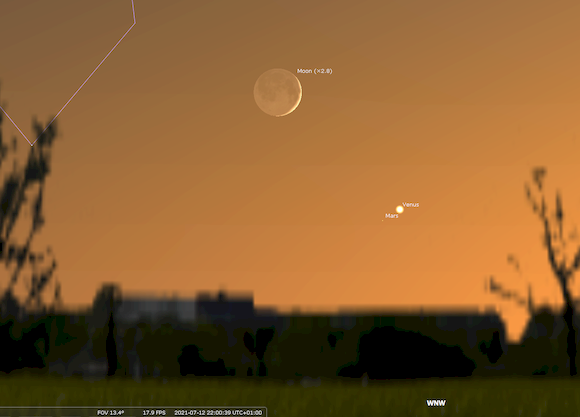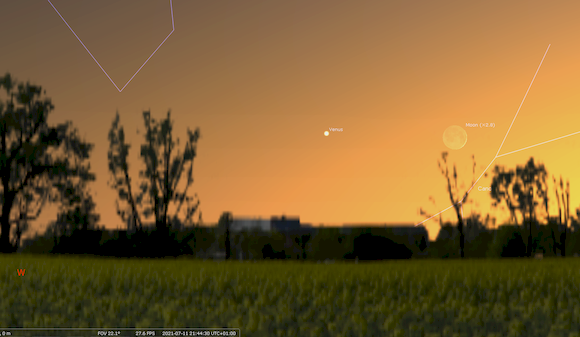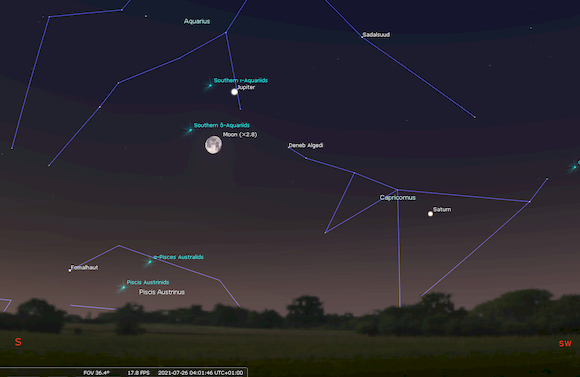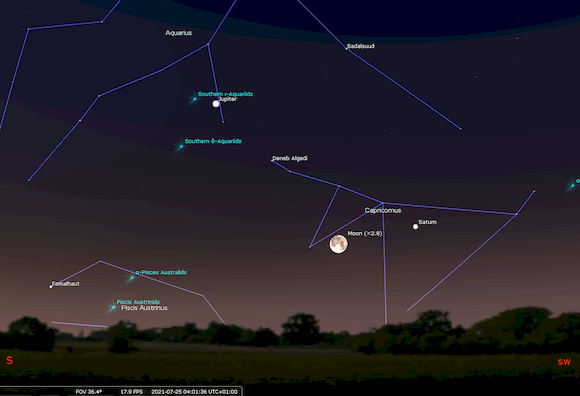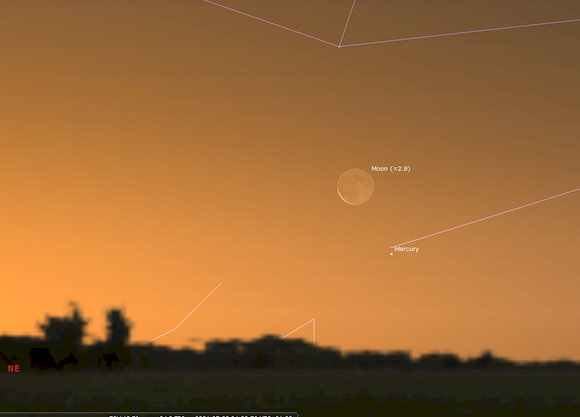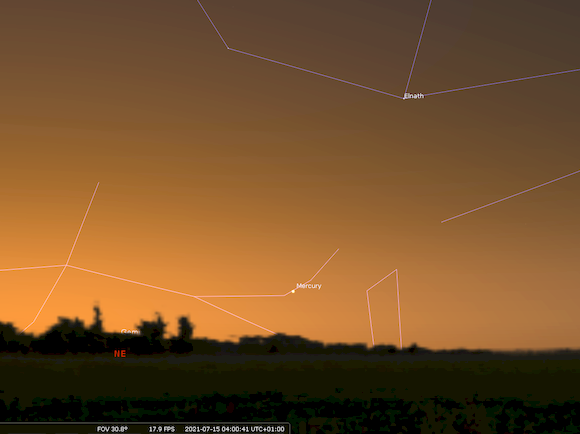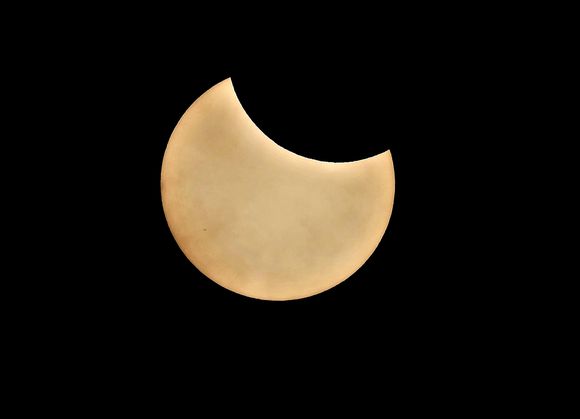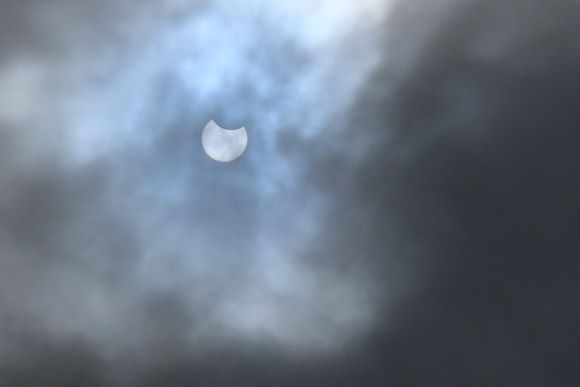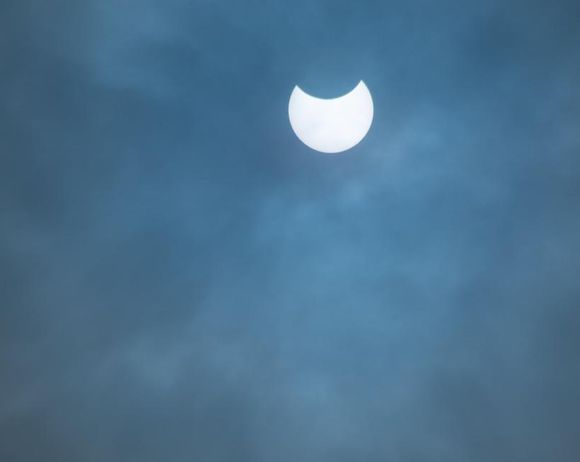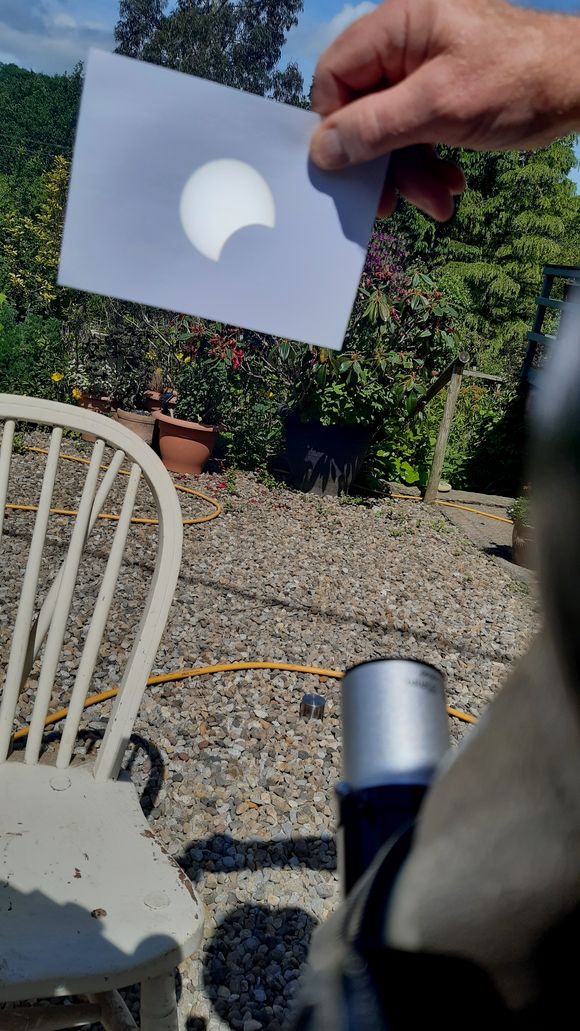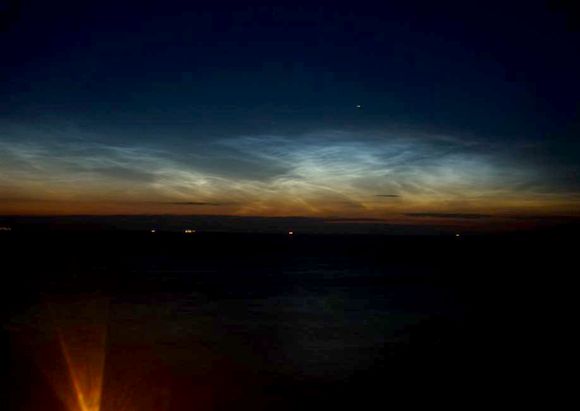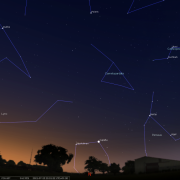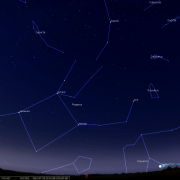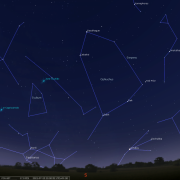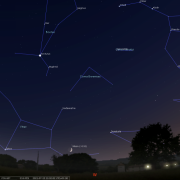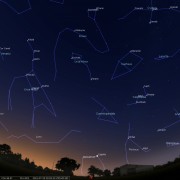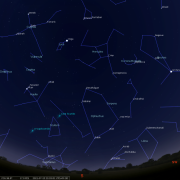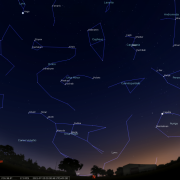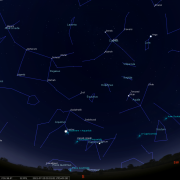In this month's Sky Notes:
- Planetary Skylights
- Partial Solar Eclipse reviews
- July Meteors
- Noctilucent cloud season - peak month
- July 2021 Sky Charts
Planetary Skylights - Brief
Mars really does depart the sky this month, but not after a close encounter with Venus very low in the WNW late evening sky. Venus, although bright, fails to really make a mark. Jupiter and Saturn can be viewed before midnight, but essentially remain overnight objects for this month.
 Mars has gradually been slipping down (probably unseen to the naked eye) into the bright twilight throughout the latter half of June, but is involved in one last planetary gettogether before departing the sky. Admittedly, it may be somewhat challenging for many, but given a clear view of the NW horizon, observing at the right time, it should be possible with optical aid to spot the red planet in conjunction with brilliant Venus. The two have been edging together since the final week of June, but are closest on the 11th, 12th and 13th of July. You will need to look roughly six degrees above the WNW horizon no later than 22:05hrs to have the best chance.
Mars has gradually been slipping down (probably unseen to the naked eye) into the bright twilight throughout the latter half of June, but is involved in one last planetary gettogether before departing the sky. Admittedly, it may be somewhat challenging for many, but given a clear view of the NW horizon, observing at the right time, it should be possible with optical aid to spot the red planet in conjunction with brilliant Venus. The two have been edging together since the final week of June, but are closest on the 11th, 12th and 13th of July. You will need to look roughly six degrees above the WNW horizon no later than 22:05hrs to have the best chance.
Venus should be quite evident, you may also spy a very young crescent moon residing to its upper left. In the bright twilight, Mars will not be visible to the naked eye, but aim a pair of binoculars at Venus and you should pick out Mars, either just to the left (11th), slightly lower left (12th) and below (13th). Both planets should lie in the same field of view. Mars will drop out of view a few days later bringing its current apparition to a close.
 Venus continues to hug the NW horizon all month, gaining very little in altitude. At magnitude -3.7 it should be readily visible to the naked eye in the evening twilight, but this brilliance is masked somewhat by the light skies in the NW. An unobstructed NW aspect will be a neccessity to spot Venus. Look for a slither of a new moon to the right of Venus on the 11th, and upper left on the 12th, view at 22:05hrs. For the second month running, observing Venus will be limited to around 45 minutes before it drops too low. The image will be somewhat unstable through the eyepiece, but a phase should be noticeable, equivalent to a lunar Qtr phase.
Venus continues to hug the NW horizon all month, gaining very little in altitude. At magnitude -3.7 it should be readily visible to the naked eye in the evening twilight, but this brilliance is masked somewhat by the light skies in the NW. An unobstructed NW aspect will be a neccessity to spot Venus. Look for a slither of a new moon to the right of Venus on the 11th, and upper left on the 12th, view at 22:05hrs. For the second month running, observing Venus will be limited to around 45 minutes before it drops too low. The image will be somewhat unstable through the eyepiece, but a phase should be noticeable, equivalent to a lunar Qtr phase.
Dawn Planets
 Jupiter and Saturn continue to make slow progress from being 'dawn' objects to becoming 'evening' objects. Even though they will both be visible well before midnight by the second half of July, they should still be considered 'overnight' objects. Residing amongst the stars of Capricornus throughout July, Saturn leads Jupiter into the sky by around 40 minutes and at magnitude + 0.2 its pearly white hue is quite conspicuous. By mid-month it is rising around 22:15hrs BST and by the month's end culminating due south shortly before midnight; a respectable 20 degrees up and can be observed until 03:00hrs. The glorious rings are still well orientated with respect to Earth, but are now slowing closing up again, with the North Pole tilted toward Earth by nearly 17 degrees. In the eyepiece Saturn remains a glorious sight, you may also note Titan, its largest moon as a speck nearby.
Jupiter and Saturn continue to make slow progress from being 'dawn' objects to becoming 'evening' objects. Even though they will both be visible well before midnight by the second half of July, they should still be considered 'overnight' objects. Residing amongst the stars of Capricornus throughout July, Saturn leads Jupiter into the sky by around 40 minutes and at magnitude + 0.2 its pearly white hue is quite conspicuous. By mid-month it is rising around 22:15hrs BST and by the month's end culminating due south shortly before midnight; a respectable 20 degrees up and can be observed until 03:00hrs. The glorious rings are still well orientated with respect to Earth, but are now slowing closing up again, with the North Pole tilted toward Earth by nearly 17 degrees. In the eyepiece Saturn remains a glorious sight, you may also note Titan, its largest moon as a speck nearby.
 Jupiter trails Saturn by around 45 minutes and is considerably more conspicuous shining at magnitude -2.7 and so should be easy to spot, unless hidden by scenery or housing. At the start of July Jupiter rises shortly before midnight amongst the stars of Aquarius, but will be at its best when an early morning object. By the end of July Jupiter will become a very late evening object, but won't culminate until 02:30hrs BST, 23 degrees above southern horizon. Through the eyepiece Jupiter is a fine sight, Galilean moons, belt features and the great red spot, all make for fascinating observations when ‘seeing’ allows. The Galilean moons can be particularly interesting to follow, as they 'dance' around Jupiter. Look for shadow transits on the generous sized disk (48 arc seconds) as well as disapearances and reapearances behind the disk. A 75mm+ scope will show these well. The best shadow transit date will be July 28th - 23:30hrs for a Europa shadow transit, with Ganymede emerging from behind the disk. The last quarter moon lies below Jupiter on the 26th.
Jupiter trails Saturn by around 45 minutes and is considerably more conspicuous shining at magnitude -2.7 and so should be easy to spot, unless hidden by scenery or housing. At the start of July Jupiter rises shortly before midnight amongst the stars of Aquarius, but will be at its best when an early morning object. By the end of July Jupiter will become a very late evening object, but won't culminate until 02:30hrs BST, 23 degrees above southern horizon. Through the eyepiece Jupiter is a fine sight, Galilean moons, belt features and the great red spot, all make for fascinating observations when ‘seeing’ allows. The Galilean moons can be particularly interesting to follow, as they 'dance' around Jupiter. Look for shadow transits on the generous sized disk (48 arc seconds) as well as disapearances and reapearances behind the disk. A 75mm+ scope will show these well. The best shadow transit date will be July 28th - 23:30hrs for a Europa shadow transit, with Ganymede emerging from behind the disk. The last quarter moon lies below Jupiter on the 26th.
 Mercury has a challenging dawn apparition, mirroring Venus in the evening sky by hugging the NE horizon and not straying too far from it. The elusive innermost planet will be visible from July 6th until just after the 20th. It will be brightest later in this period, but lower down and therefore more difficult to spot. You will need to view just above the ENE horizon around 4am. View on the 8th when a very slender crescent moon resides upper left of Mercury
Mercury has a challenging dawn apparition, mirroring Venus in the evening sky by hugging the NE horizon and not straying too far from it. The elusive innermost planet will be visible from July 6th until just after the 20th. It will be brightest later in this period, but lower down and therefore more difficult to spot. You will need to view just above the ENE horizon around 4am. View on the 8th when a very slender crescent moon resides upper left of Mercury
Partial Solar Eclipse - Review
The partial solar eclipse on June 10th was observed by several WDAS members around the district. Cloud cover blocked out great swathes of the country, preventing any meaningful observations, but for once from North Yorkshire and in particular coastal area's, the cloud was more fragmented allowing more than just glimpses of the eclipse. Locations further north of the UK actually got to witness a spectacular annular solar eclipse, with a ‘ring of fire’ around the silhouette of the New Moon, it being just too close in its orbit to allow for a total eclipse. From the Whitby area, the moon eclipsed roughly a third at maximum which occurred around 11:15hrs. Mark, who was 'working' from home had set up a TAL refractor in the back garden with neutral density filter and large white board for the projection method. The first notch appeared on the solar limb around 10:10hrs, slowly working up to maximum by 11:15hrs. Cloud cover came and went (mostly came for maximum eclipse, blotting out the Sun for almost 30 minutes), but it did disperse again, allowing further views. The bumpy terrain of the lunar limb could clearly be made out, there was even a smattering of tiny sunspots visible just ahead of the lunar limb, but you had to look carefully to spot them. Other members to view proceedings included, Keith, Phil and Elaine, Paul Ming and Paul Wood. Although only partial, the eclipse was very satisfactory to follow. There are further partial eclipse in 2025 and 2027, the latter being 90% - on an August evening! That will be one to watch!
Just after maximum eclipse - around 11:25hrs BST.
Taken through eyepiece (21mm) of TAL 100R with Thousand Oaks filter on aperture.
Camera -Lumix TZ70 on program setting - hand held at eyepiece
(click for larger image)
Partial eclipse thru' binoculars with neutral density filter.
Image: Paul Ming from Fylingthorpe-RHB (click for larger)
Elaine and Phil's view of partial- from Ruswarp. Helios 100mm scope with Solar film
(click for larger)
Paul Wood- Glaisdale, also caught the eclipse.
He used a 3.5inch Questar with 16mm eyepiece, full aperture solar filter.
Taken on iPhone SE with Celestron 81055 NexYZ smartphone holder attached to eyepiece.
(click for larger) For more shots from Paul visit
https://www.dropbox.com/sh/l5dyaf5coan2xah/AABn4f7xz_IiECGhSOkoXp8Oa?dl=0
And using the projection method - results were just as good

A number of lesser meteor showers occur during July.
- The Capri-Cornids have 3 maxima, July 8, 15, and 26, all with zenith hourly rates (ZHR) of less than 10, barely more than sporadic rates. Moon light will washout the first date, but not interfere with the other dates. Early morning hours will offer the best chance of catching a few shooting stars.
- The Alpha Cygnids peak on July 21st, but again rates are barely more than sporadic levels. Cygnus is well placed high in the SSE by midnight. Moon light will not interfere.
- The Delta-Aquarids are a little more prolific, peaking on July 30th with a ZHR of around 15. Moon light will hamper until the early hours of the morning, but this offers the best chance spotting any meteors.
There have only been a few Noctilucent Cloud displays readily evident from Whitby in June, July usually encompasses the most activie period, so it will be interesting to see if activity increases. Noctilucent cloud often appears above the northern horizon long after sunset appearing filamentary in structure with a characteristic silvery-blue colour. It forms almost exclusively between latitudes 50 and 60 degrees north at altitudes of around 50 miles, five times higher than normal clouds. It is thought Noctilucent clouds form when water vapour condenses at the low temperatures that prevail at such altitudes onto particles suspended in the air, possibly pollutants from industrial sources, even aircraft. Do then keep a watch low to the north throughout July.
Additional Image Credits:
- Planets and Comets where not otherwise mentioned: NASA
- Sky Charts: Stellarium Software and Starry Night Pro Plus 8
- Log in to post comments

